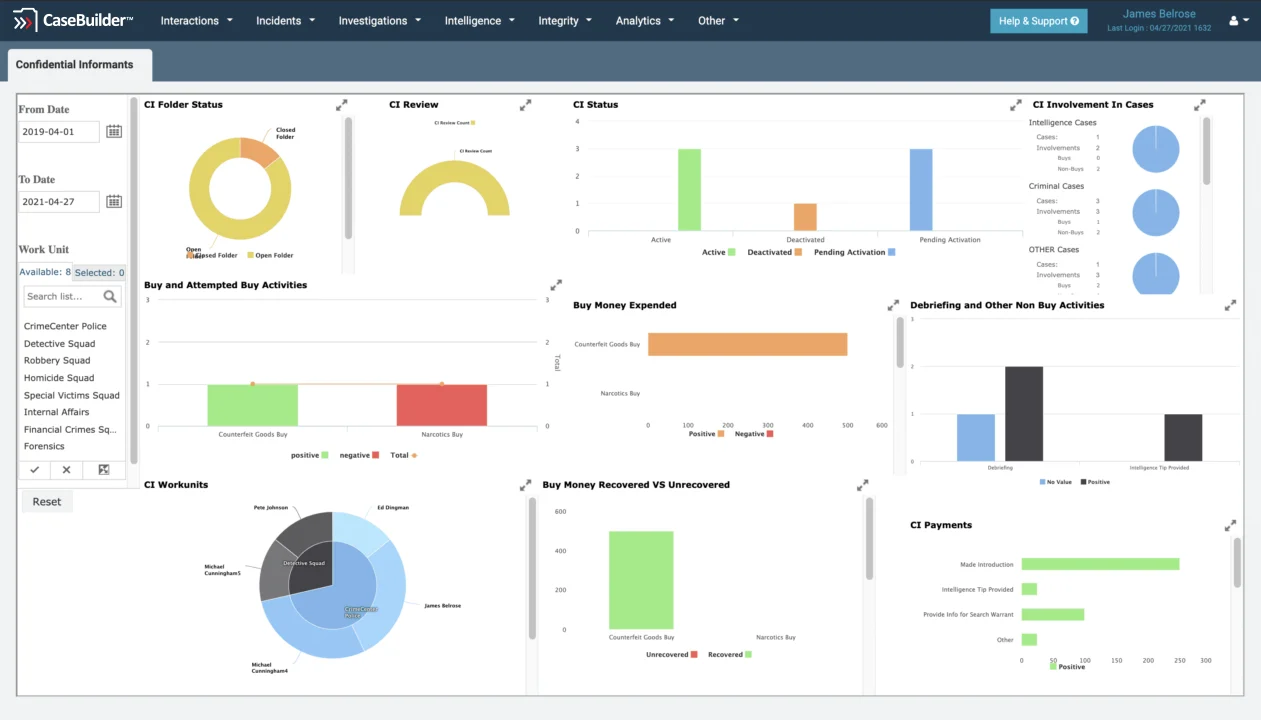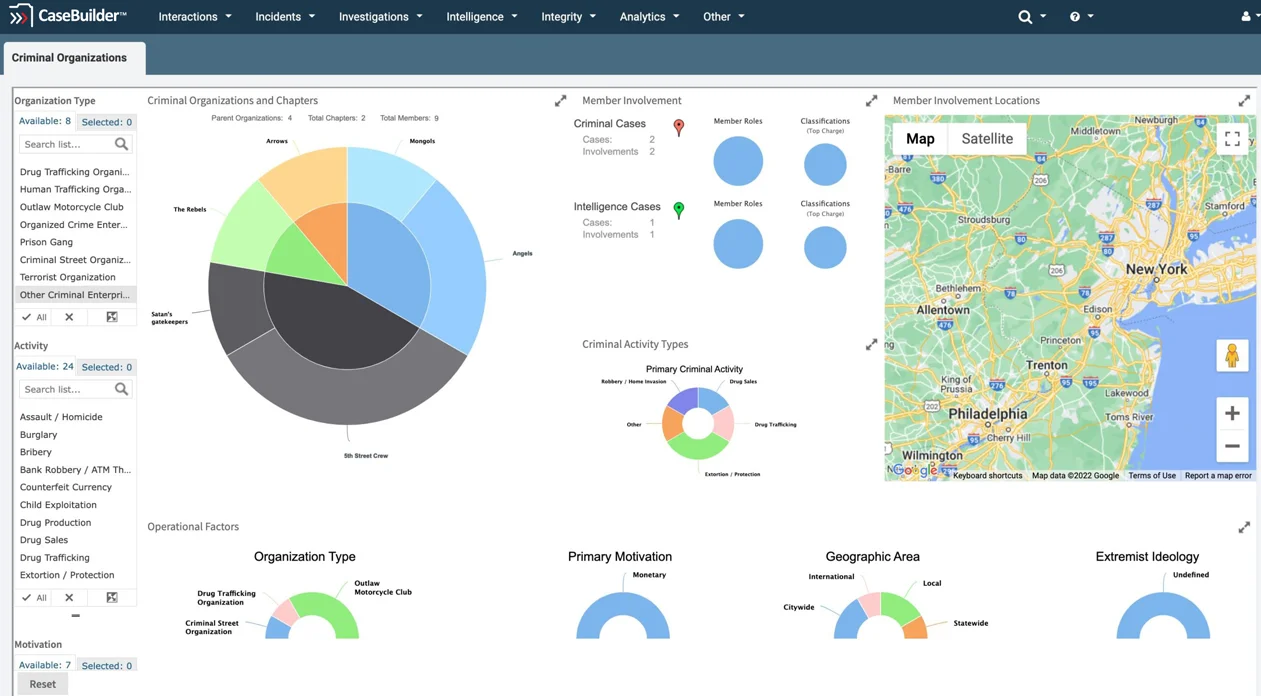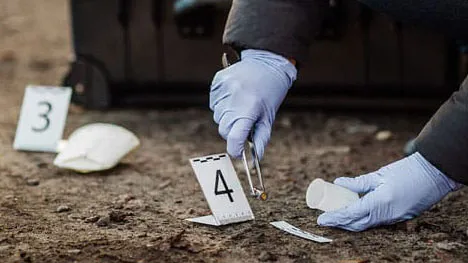Closely related to gangs are transnational organized crime (TOC) groups—also of major concern to the FBI—involved in crimes across the spectrum from drug trafficking, murder, human trafficking, money laundering, firearms trafficking, and more. These types of organized criminal enterprises tend to involve large groups of bad actors working in a coordinated fashion across state lines over the course of several months or even years. Because of this, they can present an enormous amount of obstacles for an investigative team. In this article, we will primarily cover the challenges in building a Racketeer Influenced and Corrupt Organization (RICO) case, and how a case management platform like CaseBuilder can ultimately help investigators crack down on racketeering activity.
Challenges of Building RICO Cases
The most effective way to bring down a major criminal organization and crack down on racketeering activity is to build a RICO case, but such legal cases are often complicated to build. First, law enforcement officials need to prove that an organized criminal enterprise exists. Second, they must prove that individual members accused of racketeering have each committed at least two identified criminal offenses within a 10-year period. As long as investigators can prove that the racketeering activity in question is chargeable or “indictable” under an applicable criminal statute, the individual/s or organizations that engage in racketeering can be punished with substantive penalties that include up to 25 years of imprisonment.
However, building an airtight case that proves the operation of a criminal enterprise beyond a reasonable doubt is a time-consuming endeavor. It requires a deep understanding of who is involved in the criminal enterprise and demonstrable proof of how associates are connected to one another. It often requires the assistance of confidential informants who need to be assured that their identities will be protected for their own personal safety. And it often requires coordinated collaboration with law enforcement and prosecutors at the local, state, and federal levels.
Once the case reaches the prosecutor’s desk, the uphill battle only continues. It can often take prosecutors one to two years to finalize their cases, and there is always the risk of the court dismissing charges if the prosecution fails to conclusively prove their case.
So, how can an investigative team build an effective RICO case? Hint: it’s all in the details.
Where CaseBuilder Fits In
Confidential Informant Management
It is critically important that law enforcement agencies comply with applicable laws and security standards to protect the privacy of criminal intelligence and investigative data submitted, stored, and disseminated by their system. Never are these guidelines more important than when applied to confidential informants (CIs), who feed investigators with inside information on criminal enterprises and their members. The application allows law enforcement to track CI activities, payments, performance reviews, and status. Federal law insists that all dossiers on CIs should be kept under the utmost confidentiality in order to protect the identity and safety of the informant. CaseBuilder adheres to Criminal Justice Information System (CJIS) security policies as well as US Code 28-CFR Part 23 regulations with its Confidential Informant Management that maintains rigorous privacy standards by isolating the data and inserting strict controls. These include authentication, and encryption processes as well as an audit trail that documents all activities relating to user access and modification of data within its system. Additionally, CaseBuilder supports dissemination where an investigator can selectively publish particular documents that are suitable for disclosure and track the reason why the documents were disseminated (need-to-know basis) as well as the recipient’s right to know.
Criminal Enterprise Management
Bringing down an entire criminal enterprise requires a nuanced understanding of those who are part of the criminal enterprise and meticulous documentation of their activities. With CaseBuilder’s Criminal Enterprise Management features investigators can keep close track of all of this, including any members of a criminal gang or other enterprises who have been arrested, and any intelligence work that makes note of activities or associations that may lead to other members in an organization. Investigators can also leverage the case management platform for conducting surveillance, recording interviews, and searching for linkages between the criminal enterprise and other criminal activity. Ultimately, investigative work becomes that much easier and more productive when all of this important documentation and insight is stored in one comprehensive case management folder rather than across several siloed systems.
Collaborative Case Management System
Investigators working on major cases manage an abundance of data over the course of their day-to-day investigations, such as 9-1-1 call data, audio recordings, surveillance video, incident reports, supplemental reports, public records, and a variety of photos and documents. CaseBuilder helps law enforcement assemble complex RICO cases by collating, organizing, and storing relevant data in one secure case management folder, making it easy to collaborate on relevant documents with other law enforcement agencies as well as submit reports to prosecutors. CaseBuilder’s advanced analytics help investigators identify trends and patterns in real-time, which in turn helps investigators clear cases more rapidly and accurately than they would have otherwise.
Commitment to Accuracy
As stipulated by the US Code of Federal Regulations 28 CFR Part 23, investigative data is effective only if it’s up-to-date. CaseBuilder alerts law enforcement agencies on review deadlines, so agents can determine whether their data is valid or needs to be updated. With its single pane of glass, CaseBuilder collates and shares relevant leads across the investigative team, giving stakeholders the ability to collaborate in real time and assemble their rock-solid case.
Conclusion
RICO cases need to be systematic, methodical, and cohesive for law enforcement agents and prosecutors to work together in their efforts to crack down on racketeering activity and reduce organized crime and violent street gangs. CaseBuilder’s case management system adheres to the industry’s most stringent requirements, leveraging standards and best practices set forth by the International Association of Chiefs of Police (IACP), justice information sharing (JIS), the FBI’s N-DEx using Information Exchange Package Documentation (IEPD) and the National Information Exchange Model (NIEM), enabling investigators to focus on what they do best—solving cases.







